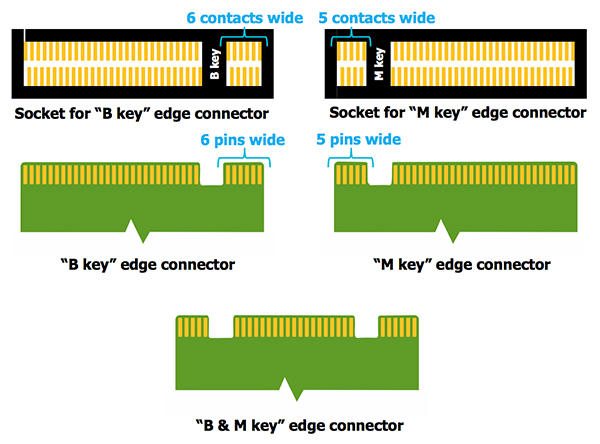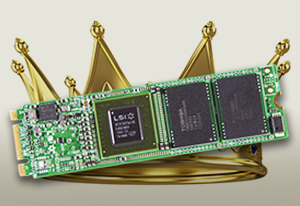Solid state drive (SSD) makers have introduced many new layout form factors that are not possible with hard disk drives (HDDs). My blog Size matters: Everything you need to know about SSD form factors talks about the many current SSD form factors, but I gave the new M.2 form factor only a glimpse. The specification and its history merit a deeper look.
The history
A few years ago the PCI Special Interest Group (PCI-SIG), teaming with The Serial ATA International Organization (SATA-IO), started to develop a new form factor standard to replace Mini-PCIe and mSATA since specifications from both of these organizations are required to build SATA M.2 SSDs. The new layout and connector would be used for applications including WiFi, WWAN, USB, PCIe and SATA, with SSD implementations using either PCIe or SATA interfaces. The groups set out to create a narrower connector that supports higher data rates, a lower profile and boards of varying lengths to accommodate various very small notebook computers.
This new form factor also aimed to support micro servers and similar high-density systems by enabling the deployment of dozens of M.2 boards. Unique notches in the edge connector known as keys would be used to differentiate the wide array of products using the M.2 connector and prevent the insertion of incompatible products into the wrong socket.
The name change
Initially the M.2 form factor was called Next Generation Form Factor, or NGFF for short. NGFF was designed to follow the dimensional specifications of M.2, a different specification from NGFF, which at that time was being defined by the PCI SIG. Soon after NGFF was announced, confusion between the identical form factors reigned, prompting the name change of NGFF to M.2. Many people in the industry have been slow to adopt the new M.2 name and you often see articles that describe these solutions as M.2, formally known as NGFF.
The keys
In the world of connectors or sockets, a key prevents the insertion of a connector into an incompatible socket to ensure the proper mating of connectors and sockets. The M.2 specification has defined 11 key configurations, seven for use sometime in the future. A socket can only have one key, but the plug-in cards can have keyways cut for multiple keys if they support those socket types. Of the four defined keys available for current use, two support SSDs. Key ID B (pins 12-19) gives PCIe SSDs up to two lanes of connectivity and key ID M (pins 59-66) provides PCIe SSDs with up to four lanes of connectivity. Both can accommodate SATA devices. All of the key patterns are uniquely configured so that the card cannot be flipped over and inserted incorrectly.

Unfortunately these keys alone do not tell the user enough about an SSD to help in the selection of replacement or upgrade drives. For example, a computer with an M.2 socket for PCIe x2 support features a B key so that no M.2 boards with PCIe x4 requirements (M key) can fit. However, even though a SATA M.2 card with a B key can fit in the same system, the host will not recognize SATA signals from the motherboards PCIe socket. With this signal incompatibility, users need to carefully read other socket specifications either printed on the motherboard or included in the system configuration information to see if the socket is PCIe or SATA.
The profile and lengths
Pin spacing on the M.2 card connector is higher in density than prior connector specifications, enabling a narrower board and thinner, lighter mobile computing systems that are smaller and weigh less. Whats more, the M.2 specification defines a module with components populating only one side of the board, leaving enough space between the main system board and the module for other components. The number of flash chips used by SSDs varies with storage capacity. The less the storage capacity requirement of an SSD, the shorter the module can be used, leaving system manufacturers more space for other components.

Its all in the name
When I hear people call this specification by the name M.2 formally known as NGFF, I cannot help but think about the time when the rock artist Prince changed his name to an unpronounceable symbol and everyone was stuck calling him The Artist Formerly Known as Prince. In his case I believe he was going for the publicity of the confusion.
As for the renaming of NGFF to M.2, I really don’t think that was the goal. In fact I believe it was intended to simplify brand identity by eliminating a second name for the same specification. No matter what we call this new form factor, it appears destined to thrive in both the mobile computing and high-density server markets.








Leave A Comment